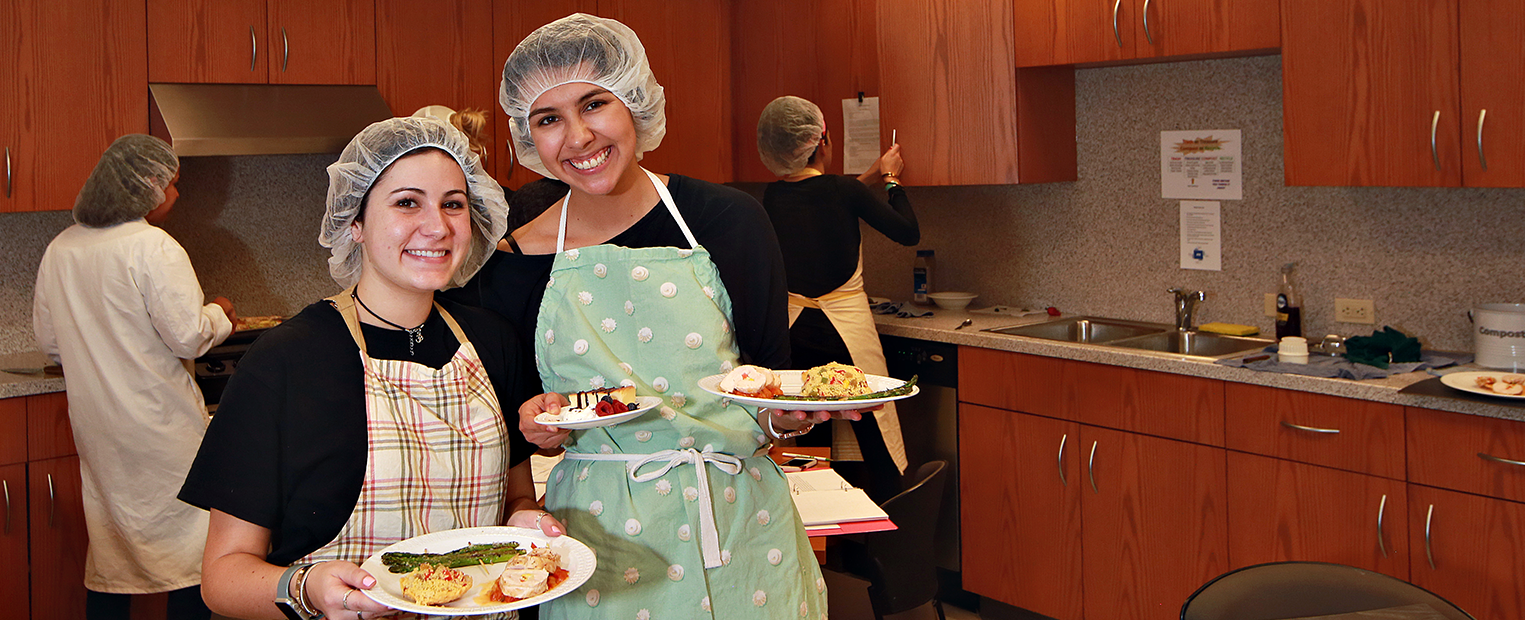It is estimated that 30-40% of the food produced in the US is wasted and mostly winds up in the landfill.
Meanwhile, food costs are very high, and food insecurity plagues many Americans. Dr. Gina Hill, chair of The Department of Nutritional Sciences (NTDT), shares more about what food waste is, the issues surrounding it, and practical ways to be a part of the solution.

What is food waste?
USDA’s Economic Research Service (ERS) defines food loss as the edible amount of food, postharvest, that is available for human consumption but is not consumed for any reason. It includes cooking loss and natural shrinkage (for example, moisture loss); loss from mold, pests, or inadequate climate control; and food waste. For the reduction goal, USDA is adopting the convention of using the general term “food loss and waste” to describe reductions in edible food mass anywhere along the food chain. In some of the statistics and activities surrounding recycling, the term “waste” is stretched to include non-edible (by humans) parts of food such as banana peels, bones, and egg shells. (Source: https://www.usda.gov/foodwaste/faqs)
How does food waste occur?
Food waste can occur at any level of the food chain for various reasons. For example, food can be wasted at the farm level because the prices are not good enough for farmers to make a profit once they hire workers to help with harvest. Or there aren’t buyers because the food doesn’t meet the standards of perfection that we are accustomed to (odd shapes, blemishes/imperfections, sizes that are too big or too small compared to standard). It can also result in losses through transportation.
At the manufacturing level, foods that are processed will inevitably result in food waste. For example, French fries or potato chips will be peeled and those peels are edible food that will likely be discarded.
A great deal of food waste happens at the retail level, in part because of how stock is rotated, and again, due to our high standards for perfection. “Best by” and “sell by” dates are a huge contributor to food waste at both the retail and the home level. In the United States, the ONLY food that is required to have an expiration date is infant formula. The “best by,” “use by,” and “sell by” dates are primarily about quality and less about safety. Think about the crispness of a food product rather than if the product will make you ill. However, many consumers live and die by these dates, which further exacerbates the problems related to food waste.
At the foodservice/restaurant level, the biggest contributor is plate waste or what people leave on their plates rather than taking their leftovers home to eat later. Other causes include poor predictions of needs or forecasting, the need to have food ready-to-go for customers, and improper storage techniques also contribute.
At the home level, people tend to make unnecessary impulse purchases or buy things in bulk that they don’t then use. Many Americans lack basic cooking skills and aren’t as comfortable utilizing ingredients for multiple meals or repurposing leftovers for another meal in the future. Improper food storage also contributes to food waste at home. Lastly, busy schedules can also change our good intentions to prepare dinner, but after a long day of work or school, we find that it is easier to pick something up that takes far less work to prepare.
Why is this an issue? What are the implications?
Food waste is a big problem for a variety of reasons. First and foremost, in my mind, it is that despite food being thrown away, we have many individuals who have food insecurity and don’t know where their next meal will come from. Low food security is defined as reports of reduced quality, variety or desirability of diet with little or no indication of reduced food intake. Very low food security is a more extreme type of food insecurity with disrupted eating patterns and reduced food intake. Those food secure have enough food access for an active, healthy life for all household members. In October 2023, the USDA’s Economic Research Service (ERS) released a report stating that during 2022, 12.8% of US households were food insecure at least some time during the year, including 5.1% with very low food security. These rates of low and very low food insecurity were significantly higher than rates in both 2020 and 2021. Therefore, food is being wasted while people are literally unable to meet their nutritional needs in some cases. One in every 8 Americans are not food secure.
Another big problem with food waste is the environmental impact of that waste. All the resources that went into producing that food are also wasted. This includes the fuel for farm equipment and energy for transportation from the farm to factory, restaurants, grocery stores, and our homes; the energy to cook and cool the food, the seeds, the water used to help it grow, the land used to grow that food that was not then used for another purpose, the list goes on. In addition, as food decomposes, it releases greenhouse gases that are bad for the environment. Filling the landfills up with food also impacts the life of our landfills. Each semester, students enrolled in my Community Nutrition and Public Health and I visit a local landfill as part of our studies related to food waste. It is amazing to watch the constant stream of garbage trucks drive into the landfill. Over ten years ago, the City of Fort Worth conducted an audit and found that 27% of what was in the audited garbage truck was compostable material. The landfill that we observe in my class appears to be very well run. It is up to citizens to address these waste (and recycling) issues in our own homes.
Wasted food has an economic impact. According to the organization, ReFed, food waste costs the US economy $428 billion (about $1,300 per person in the US) in 2022. The cost is greatest for consumers.
What are some viable solutions at large?
The EPA uses a food recovery hierarchy diagram to explain the priorities, which include source reduction, feed hungry people, feed animals, industrial uses (such as utilizing food scraps to produce energy), composting and lastly landfill. Some big picture solutions are in effect in some places. For example, in France, large grocery stores are banned from throwing away edible food. Gleaning is an old practice used to gather food that is left in fields after harvest. Local gleaning opportunities exist in North Texas.
What are practical ways individuals can prevent food waste?
- Meal plan. There are a lot of things that we can do at the home level such as plan meals and plan for leftovers. Shop using a list with meals in mind and shop our own refrigerators and pantries before going to the grocery store. Make sure that we store our food properly to prevent spoilage. We can also be more accepting of imperfect food and open to purchasing vegetables or fruits that are oddly shaped, but still completely wholesome to consume
- Make friends with our freezers. For example, if you make soup, but are tired of the leftovers, then freeze them into individual portions to have for lunch or dinner in a few weeks when you may be excited to eat that food again. If berries are starting to deteriorate, freeze them to use in muffins or smoothies later. Think about how something can be used up completely before purchasing. For example, I rarely buy lettuce because I can use spinach, kale, and Swiss chard for a more things such as sauteed greens, salads, smoothies and in soups or casseroles. Save veggie scraps such as onion skins, carrot tops and other scraps to make veggie broth at home. Keep a bag of veggie scraps in the freezer and make broth when it is too full to fit anything new or when broth is needed for a recipe. Share meals at restaurants. Restaurant portions are often enormous. If someone doesn’t love leftovers, then it is better to share and not waste the food.
- Compost. Although composting is only right above landfill on the food recovery hierarchy, composting at home is an option. If a compost pile is well maintained, it doesn’t smell, and it can be used to add nutrients back to the soil in the yard or garden. If someone doesn’t have the space or the desire, the City of Fort Worth has a municipal composting option for residents to take part in. I have chickens in my backyard, and they happily eat food scraps from my kitchen.
- Don’t rely on the "use by," "best by" and "sell by" dates: Just because a food hasn’t reached the sell by, use by or sell by date, it isn’t necessarily safe depending on how it was handled and stored. On the flip side, the sell by dates are about quality and not safety, so pay attention to how food looks, smells, and feels and make sure to store it properly from the time that you pick it up from the grocery store all the way to how it is handled while cooking, cooling and reheating. Don’t toss food simply because the date is approaching or past. Be an advocate to help address food waste. People can educate their families and friends about the use by, sell by and best by dates and encourage those in their circles to take steps to decrease food waste in their lives.
- Give food away! Sometime people feel strange about this, but we need to get over it. My neighborhood block has a text group. When someone is leaving for vacation and they have a ½ gallon of milk or some fruit that would go to waste, they offer it up on the group text. Did you buy bagels that no one in your house likes? Ask your friends if anyone would want them. I recently was given a big bag of chia seeds by a neighbor who thought she would use them and then realized that she wouldn’t. I know my neighbors well and wouldn’t hesitate to take food from them, even if it is already open. Most unopened food and produce can be donated to local organizations such as the Tarrant Area Food Bank or Funky Town Fridge.
How is The Department of Nutritional Sciences (NTDT) helping this cause? 
NTDT teaches our students how to decrease food waste so that they can then be the leaders to help with this issue in their careers in the food industry or with their clients/patients. NTDT has food labs, and the food is composted through a company called Cowboy Compost, which picks up the materials. In addition, many of our students are members of the Food Recovery Network (FRN), which is a student organization that takes unserved, wholesome food from TCU’s campus and delivers it to Union Gospel Mission (UGM) where individuals served by UGM are fed. This student organization is open to students in any major on campus and it is a great way to help address this problem. We have partnered with Sodexo on campus since we first discussed beginning an FRN chapter on TCU’s campus. They have been great partners to the TCU FRN.
Learn more about NTDT here.
